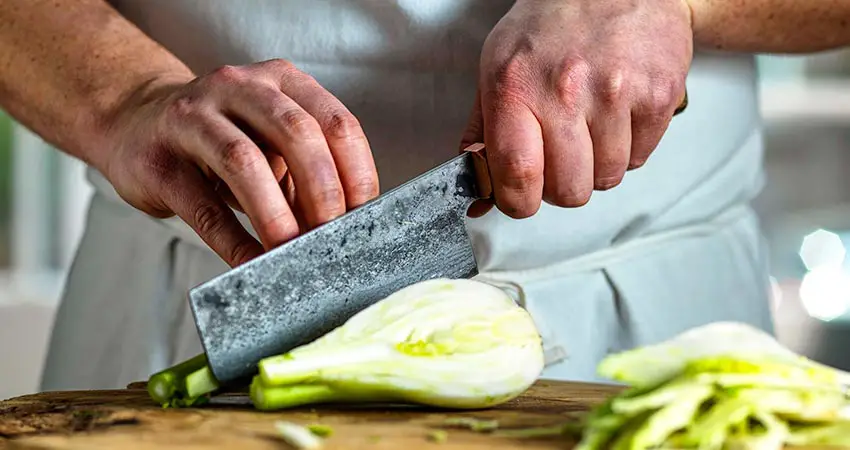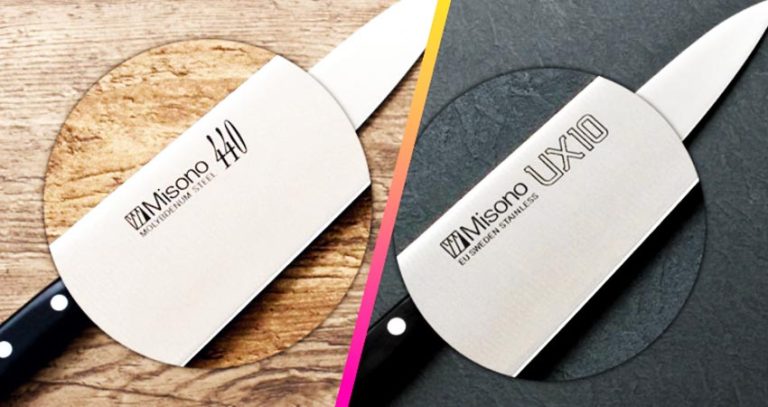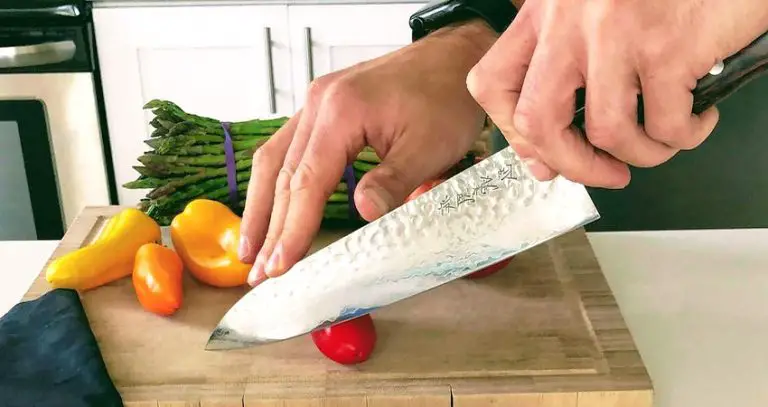How To Use a Japanese Nakiri Knife?
Are you thinking of investing in the best Japanese Nakiri knife?
However, there is one problem, you don’t know how to use this vegetable knife. In other words, you have no idea which gripping or cutting technique to use to achieve that perfect cut each time.
Hey, you don’t need to be discouraged. Learning to use a Nakiri knife is pretty simple, even if you are not a professional cook. This is partly because of its lightweight and double-bevel blade design.
One of the things you’ll have to master is the art of holding the knife and how to position your hand.
Now, in this article, we will look at the different methods of using your Japanese Nakiri knife. So, keep reading.
How To Use A Japanese Nakiri Knife?
Knowing what a Nakiri knife is used for is one thing. But learning the correct technique for using this knife is a whole different thing. So, below are some tips on how to use your Japanese Nakiri knife.
Use a Proper Gripping Technique
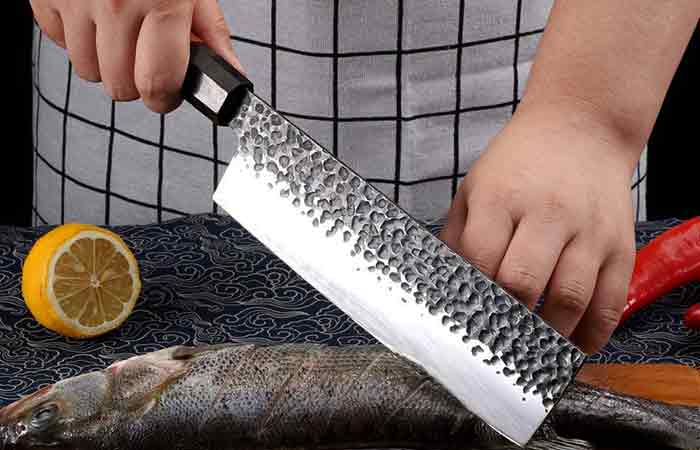
There are a few techniques for holding your Nakiri knife. You could use the pinch grip or the pointed grip.
It all depends on which technique you find comfortable. So, we recommend trying both gripping methods.
- When it comes to a pinch grip, you hold your knife with your thumb and index finger for better control.
This means your other fingers should be wrapped either under or around the handle. Overall, this is the best method because a Nakiri knife has a straight blade with a smooth edge.
- For better control and accuracy, you can use the pointed finger grip method.
This technique requires you to place your index finger onto the spine of your Nakiri knife. As for the rest of the fingers, you should wrap them around the handle.
Use Up-Down Cutting Motion
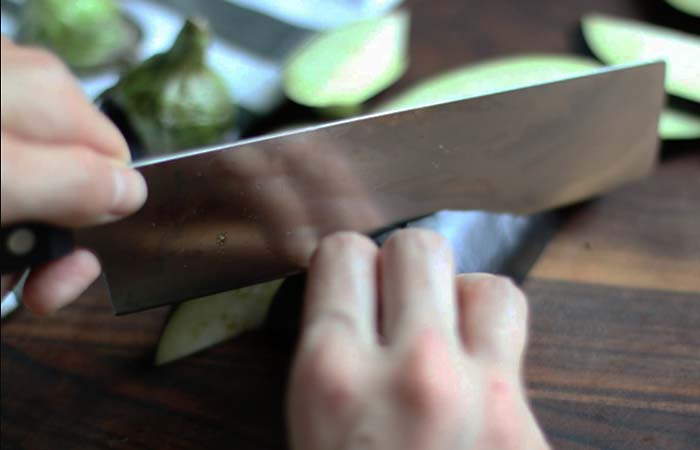
With most knives, you have to use a rocking motion to cut your ingredients. But with a Nakiri blade, you move it in an up and down motion as you slice through your vegetables.
- To put it simply, the cutting edge of your knife’s blade should hit the chopping board at the same time.
- You simply hold your knife in a horizontal position above your veggies.
- Then, gently slide it downwards and forward to make an even cut.
- Next, pull it back along your chopping board to complete the cut.
Fingers Should Stay Bent in a Claw Shape
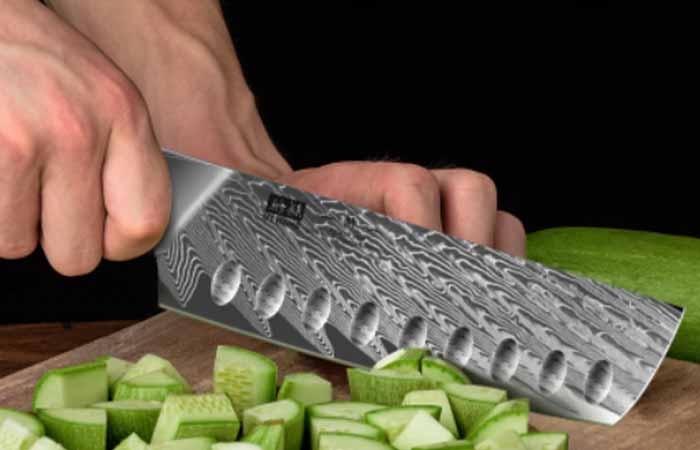
While using your Nakiri knife, you need to keep your fingertips out of the way. This way, you can minimize accidents as much as possible.
You can do this by using the claw grip technique.
- This involves using your left hand to hold your ingredients in place while keeping your fingers in a claw shape. In other words, your fingers should be tucked back but the knuckles in a slightly forward position.
- This way, they can serve as a guide for your knife. And if you apply this technique correctly, you should feel the knife gently touching your knuckles.
Sharpen The Blade Before Use

If you want to achieve clean and precise cuts, you must sharpen your Nakiri knife before use.
- You have to apply more effort with a dull blade while cutting your veggies. However, you don’t need to sharpen the knife every time you have to use it.
- Generally, the best way to sharpen your Japanese Nakiri knife is at an 18 to 20-degree angle. You can choose to use either a whetstone or diamond stone.
Maintain The Correct Posture

You have to maintain a specific posture while using your Japanese Nakiri knife.
- The correct posture involves placing your cutting arm at a 45-degree angle to your body. This way, your knife’s blade will be in an almost horizontal position against the cutting board.
- You want to avoid putting your hand in front of you because it is going to end up running into your lower body. As a result, it will be hard to cut your veggies using the up and down motion.
Always Use a Chopping Board
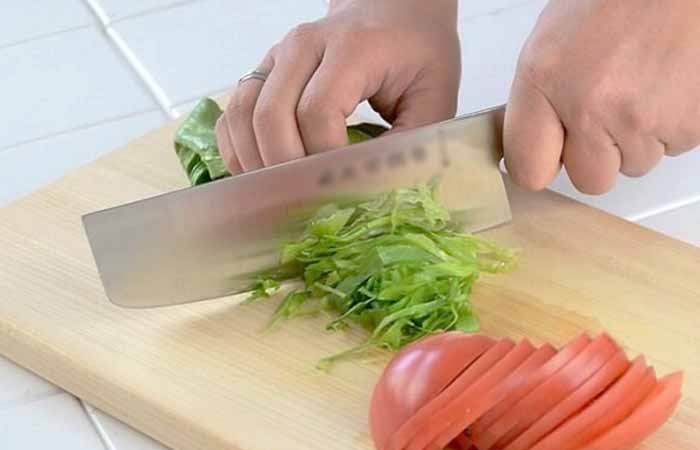
- For the best cutting performance, you must use your Nakiri knife along with a cutting board. This will ensure your edges don’t get damaged for long-lasting durability.
- Most importantly, you must make sure your chopping board does not move around as you chop your ingredients. You can prevent this from happening by putting a folded kitchen towel under the board.
Apply Minimal Pressure
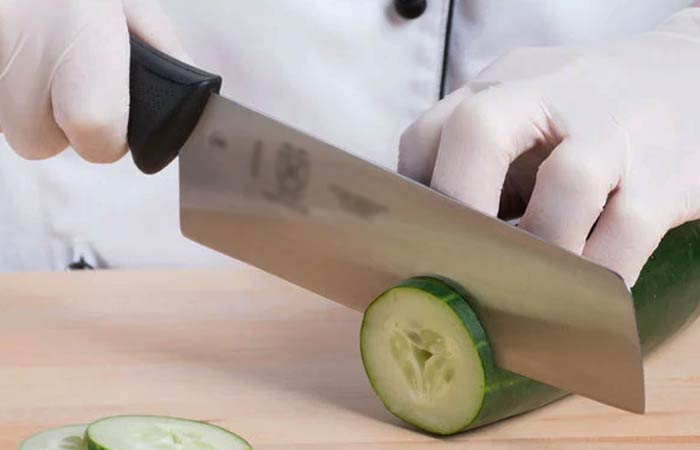
A Japanese Nakiri knife is extremely sharp and light in weight compared to most traditional kitchen knives.
- Therefore, you don’t have to use too much force when chopping your vegetables. You just glide the knife up and down with minimal strength and let the blade do the work.
- Simply put, your hand should be in a relaxed position. So, no need to slam the blade. This helps ensure you don’t tire out pretty fast, especially when preparing so many ingredients at once.
- However, you must maintain a firm grip for accurate and smooth cutting.
Only Use The Knife For The Purpose
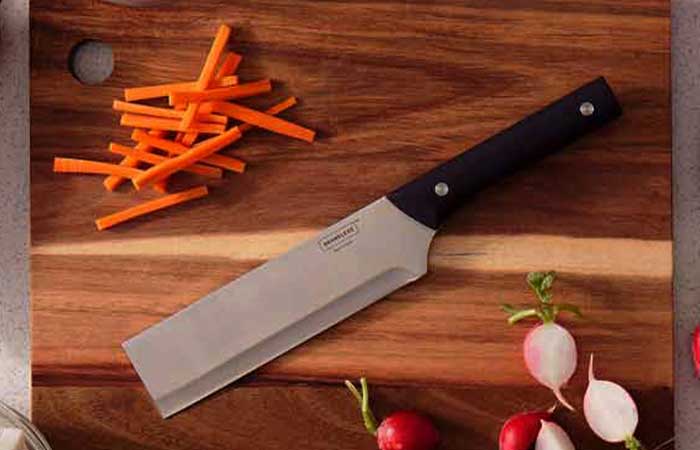
A Nakiri knife is specially designed for chopping and slicing vegetables without damaging them. You can also use it to cut fruits and small herbs. This is thanks to its flat and thin blade.
However, if you use it to cut ingredients other than vegetables, you might end up damaging its edges. So, don’t be tempted to use your Nakiri knife to cut steak or meat.
Clean After Each Use
Each time you use your Nakiri knife, you must clean it immediately to ensure its long-lasting performance.
In other words, you should not leave it dirty in the sink for hours. Also, you should not clean the knife in your dishwasher or use a rough scrubber to wash it.
- Basically, to clean this vegetable knife, all you need is warm water, dish wash soap, and a towel.
- With this, you just dip your towel in the water-soap solution and wipe your knife clean.
- Then, use a dry kitchen towel to wipe off any traces of water on the knife.
Extra Safety Tips for Using a Nakiri Knife
Because of its straight blade tip, a Nakiri is safer to use than knives with a sharp pointed tip. Even so, here are some additional safety tips for using this Japanese vegetable knife.
Tip#1: Make sure to cut your vegetables away from your body by keeping your knife’s blade facing toward the chopping board.
Tip#2: If cutting large pieces of vegetables like cabbages or onions, first cut them in half. Then, work one half at a time.
Tip#3: While cutting your ingredients, you should constantly move your Nakiri blade in a smooth motion throughout. And don’t move the knife sideways.
Tip#4: For added control over your cuts, try to keep your index finger close to the blade while chopping your veggies.
Tip#5: Don’t use your Nakiri knife in a rocking motion or any other type of cutting technique. Just stick to the up and down technique to ensure you get straight cuts.
Tip#6: Your fingers should always be tucked in behind the knuckle to minimize accidents.
Conclusion
Sure, a Nakiri knife is pretty easy to use, even for beginners. Even so, using this type of blade takes skill if you want to get quality cuts and avoid risking injuries.
For instance, you must learn to keep your hand at a 45-degree angle while chopping your ingredients. On top of that, you have to use the right gripping technique to ensure you have excellent control of the knife.
What’s more? You must master the art of keeping your fingers holding the vegetables in a claw shape.
This way, you can minimize accidents as much as possible. More importantly, you eventually have to learn to sharpen and clean your Nakiri knife correctly for long-lasting durability.

